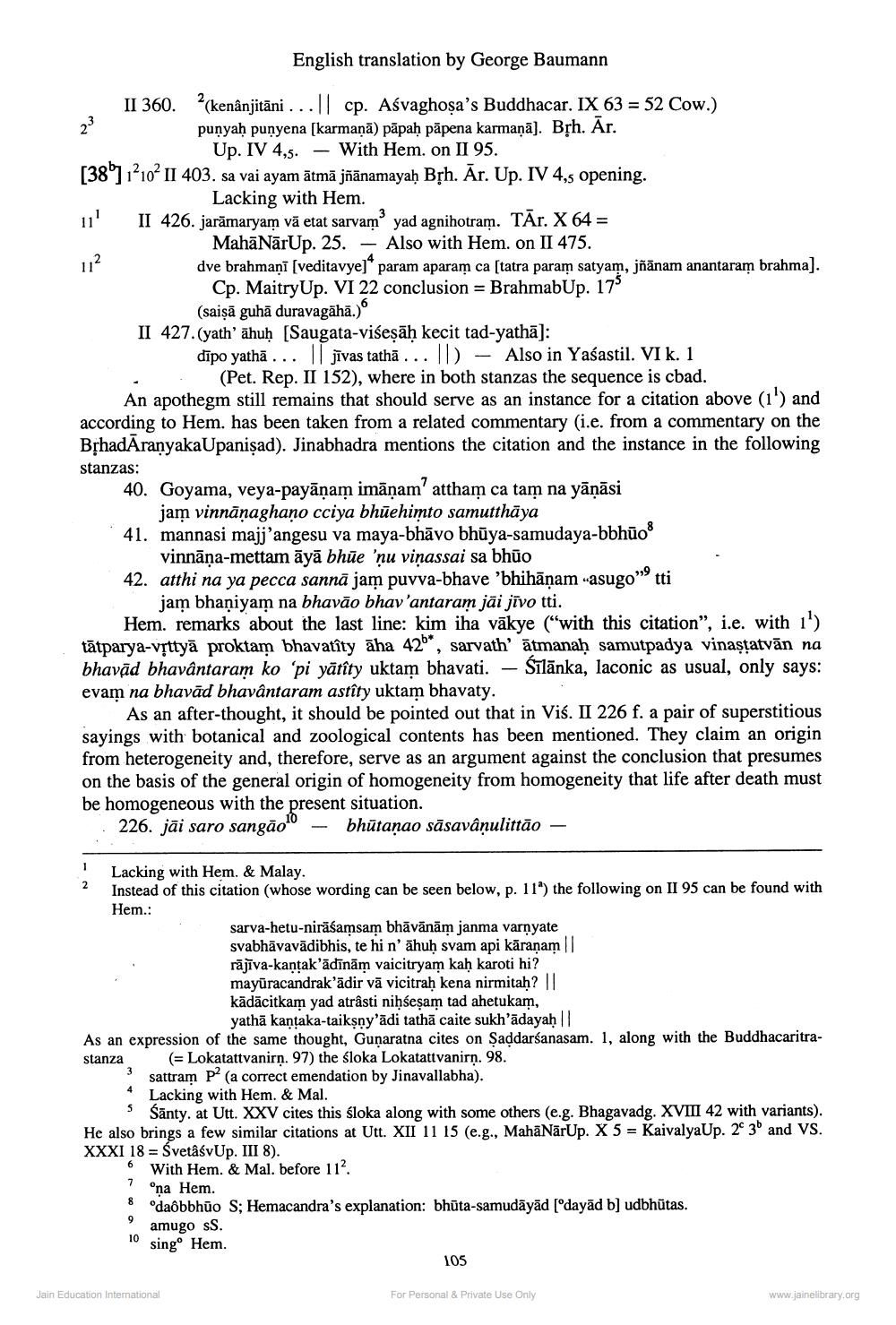________________
English translation by George Baumann
23
II 360. 2(kenânjitāni . . . || cp. Ašvaghosa's Buddhacar. IX 63 = 52 Cow.)
punyah punyena [karmaṇā) pāpaḥ pāpena karmaṇā). Bļh. Ar.
Up. IV 4,5. – With Hem. on II 95. [38]?102 II 403. sa vai ayam ātmā jñānamayah BỊh. Ār. Up. IV 4,5 opening.
Lacking with Hem. u' II 426. jarämaryam vā etat sarvamyad agnihotram. TĀr. X 64 =
MahāNārUp. 25. - Also with Hem. on II 475. dve brahmani (veditavye] param aparam ca statra para satyam, jñānam anantaram brahma).
Cp. MaitryUp. VI 22 conclusion = BrahmabUp. 178
(saiņā guhā duravagāhā.) II 427.(yath' āhuh (Saugata-višeşāh kecit tad-yathā]:
dīpo yathā ... Il jīvas tathā ... ID) – Also in Yaśastil. VI k. 1
(Pet. Rep. II 152), where in both stanzas the sequence is cbad. An apothegm still remains that should serve as an instance for a citation above (1') and according to Hem. has been taken from a related commentary (i.e. from a commentary on the BỊhadĀranyakaUpanişad). Jinabhadra mentions the citation and the instance in the following stanzas: 40. Goyama, veya-payāņam imāņam' attham ca tam na yāņāsi
jam vinnānaghano cciya bhūehimto samutthāya . 41. mannasi majj'angesu va maya-bhāvo bhūya-samudaya-bbhūo
vinnāņa-mettam āyā bhūe 'ņu viņassai sa bhūo 42. atthi na ya pecca sannā jam puvva-bhave 'bhihāņam asugo" tti
jam bhaniyam na bhavāo bhav'antaram jāi jīvo tti. Hem. remarks about the last line: kim iha vākye ("with this citation", i.e. with 1') tātparya-vịttyā proktam bhavatîty āha 420, sarvath' ātmanaḥ samutpadya vinaştatvān na bhavād bhavântaram ko 'pi yātîty uktam bhavati. – Sīlānka, laconic as usual, only says: evam na bhavād bhavântaram astîty uktam bhavaty.
As an after-thought, it should be pointed out that in Vis. II 226 f. a pair of superstitious sayings with botanical and zoological contents has been mentioned. They claim an origin from heterogeneity and, therefore, serve as an argument against the conclusion that presumes on the basis of the general origin of homogeneity from homogeneity that life after death must be homogeneous with the present situation.
226. jāi saro sangão - bhūtaņao sāsavânulittāo -
Lacking with Hem. & Malay. Instead of this citation (whose wording can be seen below, p. 11") the following on II 95 can be found with Hem.:
sarva-hetu-nirāśamsam bhāvānām janma varnyate svabhāvavādibhis, te hi n' āhuḥ svam api kāraṇam | rājīva-kantak'ādīnām vaicitryam kah karoti hi? mayūracandrak'ādir vā vicitrah kena nirmitah? || kādācitkam yad atrasti nihśesam tad ahetukam,
yathā kanțaka-taikṣny'ādi tathā caite sukh'ādayah 11 As an expression of the same thought, Gunaratna cites on Şaddarśanasam. 1, along with the Buddhacaritrastanza (= Lokatattvanirn. 97) the sloka Lokatattvanirn. 98.
3 sattram P (a correct emendation by Jinavallabha). 4 Lacking with Hem. & Mal.
5 Sänty. at Utt. XXV cites this sloka along with some others (e.g. Bhagavadg. XVIII 42 with variants). He also brings a few similar citations at Utt. XII 11 15 (e.g., MahāNārUp. X 5 = KaivalyaUp. 2° 3 and VS. XXXI 18 = SvetâśvUp. III 8).
6 With Hem. & Mal. before 112.
ona Hem. 8 °daôbbhūo S; Hemacandra's explanation: bhūta-samudāyād ["dayād b) udbhūtas.
amugo ss. 10 singo Hem.
105
Jain Education International
For Personal & Private Use Only
www.jainelibrary.org




